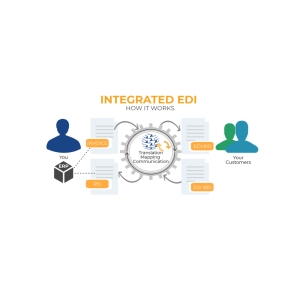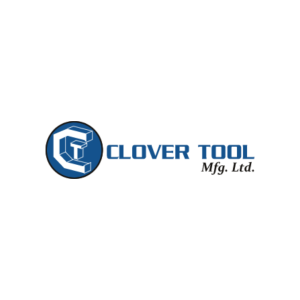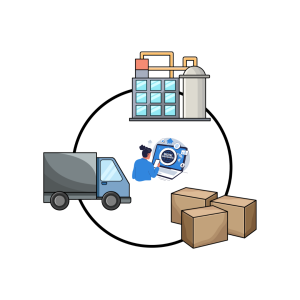Introduction
Did you know global e-commerce spending is on track to hit $6.8 trillion by 2028? That’s a massive digital shelf opportunity most businesses aren’t fully prepared to capitalize on.
Here’s why these matters: 79% of online buyers choose to shop from businesses that provide consistent customer experiences across channels, while 73% make purchase decisions based on the quality of your product content. However, 48% of companies still struggle to aggregate product feed data across their systems.
The consequences are clear. When shoppers encounter poor product information, 42% abandon their carts due to inadequate product images or videos. This directly impacts your bottom line.
We understand these challenges firsthand. Digital shelf optimization isn’t just about having an online presence—it’s about creating a seamless, information-rich experience that converts browsers into buyers. Unfortunately, 78% of enterprise leaders report high collaboration drag on critical initiatives like omnichannel orchestration.
Key Takeaways
- Audit and centralize first: Conduct a comprehensive data audit to identify fragmented product information, then implement a PIM system to create a single source of truth for all product data across your organization.
- Integrate GDSN for seamless syndication: Connect your PIM system with GDSN to automatically distribute standardized product information to retailers and marketplaces in real-time, ensuring compliance and consistency.
- Leverage analytics for continuous optimization: Use digital shelf analytics to monitor content quality, track performance metrics, and automate updates across channels to maintain a competitive advantage.
- Address the urgency: With 73% of purchase decisions based on product content quality and 42% of shoppers abandoning carts due to poor product information, implementing these systems is critical for capturing e-commerce growth.
Understanding the Digital Shelf and Its Challenges
The digital shelf represents far more than simply listing products online. Unlike its physical counterpart, the digital shelf encompasses every online environment where your products appear. This virtual ecosystem has fundamentally altered how consumers discover, research, and purchase products.
What is a digital shelf?
The digital shelf comprises all possible digital touchpoints where shoppers can interact with your products. These include retailer websites, direct-to-consumer (D2C) platforms, third-party marketplaces, mobile shopping apps, and social commerce.
Rather than being confined to a single aisle in a physical store, the digital shelf is essentially endless and constantly evolving. Furthermore, shoppers use these platforms not just for transactions but as research tools and discovery points for new products and promotions.
Why Digital Shelf Management is more Complex Today
Managing the digital shelf has grown exponentially more complicated for several reasons. First, the shopping journey has become nonlinear and omnichannel. Customers may browse a retailer’s site, check Amazon, and then visit a physical store before making a purchase. Additionally, consumer behavior evolves at a seemingly constant pace, accelerated by mobile ubiquity and pandemic-driven shopping changes.
Traditional operational models struggle with this new reality. Consider that physical stores typically have annual or semi-annual shelf resets and monthly marketing reviews. In contrast, the digital shelf requires daily assortment decisions, dynamic pricing strategies, and always-on marketing with continuous optimization. Moreover, manual forecasting of inventory typically achieves only 60% accuracy, resulting in a 10% increase in inventory costs.
Common issues with fragmented product data
Product data fragmentation creates significant challenges across the digital shelf:
- Scattered information – Data becomes dispersed across different systems and storage locations, creating both physical fragmentation (across devices) and logical fragmentation (duplicated or divided across applications)
- Departmental silos – Communication barriers between teams lead to inefficiency and duplication in work, particularly as organizations grow
- Inconsistent presentation – Each digital channel has different content requirements, creating what experts call “brand disconnect,” where products appear differently across touchpoints
- Manual processes – Reliance on spreadsheets and manual tasks introduces errors and inefficiencies, especially for large product catalogs
The consequences of these issues extend beyond operational headaches. For complex products, especially, inconsistencies across channels can erode trust and damage brand credibility. Furthermore, disorganized product information often leads to delayed launches, missing crucial market opportunities.
Addressing these challenges requires a systematic approach to digital shelf management—one that centralizes and standardizes product information across all touchpoints.
Step-by-Step Setup of PIM for Digital Shelf Success
Implementing a Product Information Management (PIM) system requires a methodical approach to ensure digital shelf success. Let me walk you through the essential steps for proper implementation.

Step 1: Audit your current product data sources
First, conduct a comprehensive data audit to understand your current product information landscape. This process involves scrutinizing all existing data sources, including how the data is created and structured. A thorough audit helps identify gaps, inconsistencies, and duplications across your organization’s product information. During this stage, evaluate the quality, importance, and usefulness of your data by examining its sources, creation methods, and structure.
This critical foundation allows you to separate valuable data from outdated or inaccurate information, ultimately enhancing operational efficiency and transparency about who uses sensitive data and for what purpose.
Step 2: Choose the right PIM software
Second, select a PIM solution that aligns with your specific digital shelf requirements. Look for software that:
- Supports unlimited categorization and variant axes for easy product scaling
- Offers robust validation capabilities for defining category-specific rules
- Governs all product content in one place—from core data to digital assets
- Enables channel-specific content versions with proper mapping tools
- Integrates seamlessly with your existing tech stack
Additionally, consider whether you need cloud-based architecture that requires zero hardware maintenance and provides immediate access to new features.
Step 3: Centralize and standardize product information
Third, consolidate all your product information into a single, accessible system. This centralization creates a reliable source of truth, ensuring consistency and accuracy across all channels. Standardized data structured in a uniform format is easier to process, eliminates redundancies, and accelerates the creation of compelling product content.
The benefits of a PIM solution extend beyond operational efficiency—centralized data leads to better decision-making through improved analysis and reporting capabilities.
Step 4: Set up workflows and user roles
Finally, establish clear workflows and user roles within your PIM system. Implement data governance programs with standard practices, rules, and policies applicable across your organization. Assign data stewards responsible for executing these governance policies. Define user access levels and permissions based on roles to maintain data security while allowing necessary collaboration.
Consequently, your PIM will serve as a centralized hub accessible to all teams involved in the product lifecycle, removing silos and accelerating time-to-market by ensuring everyone works from the latest, most accurate data.
Integrating GDSN for Seamless Syndication
After establishing your PIM system, the next crucial step toward digital shelf excellence involves connecting to the Global Data Synchronization Network (GDSN). This connection forms the backbone of seamless product data syndication across your entire retail ecosystem.
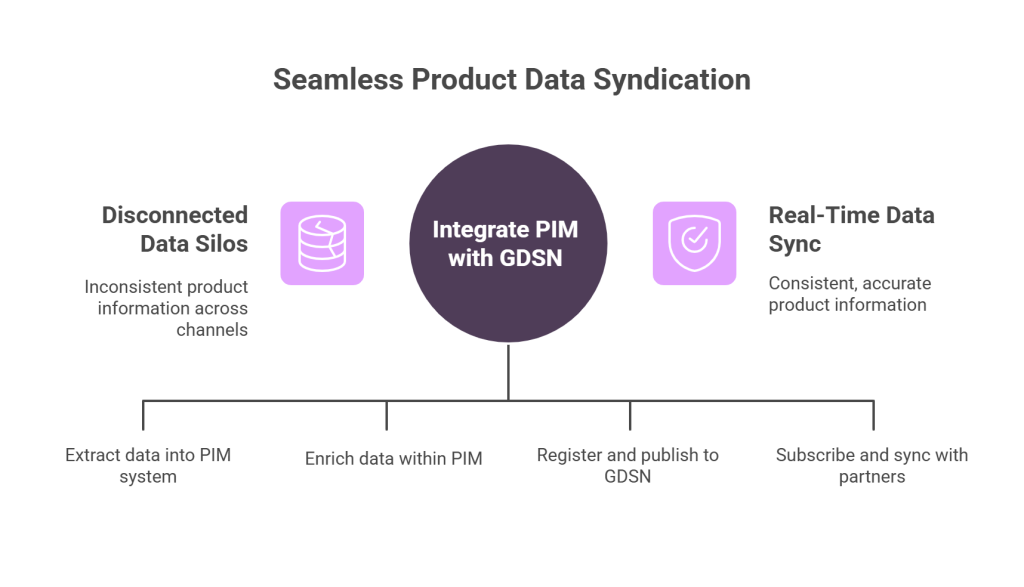
What is GDSN and How it Works
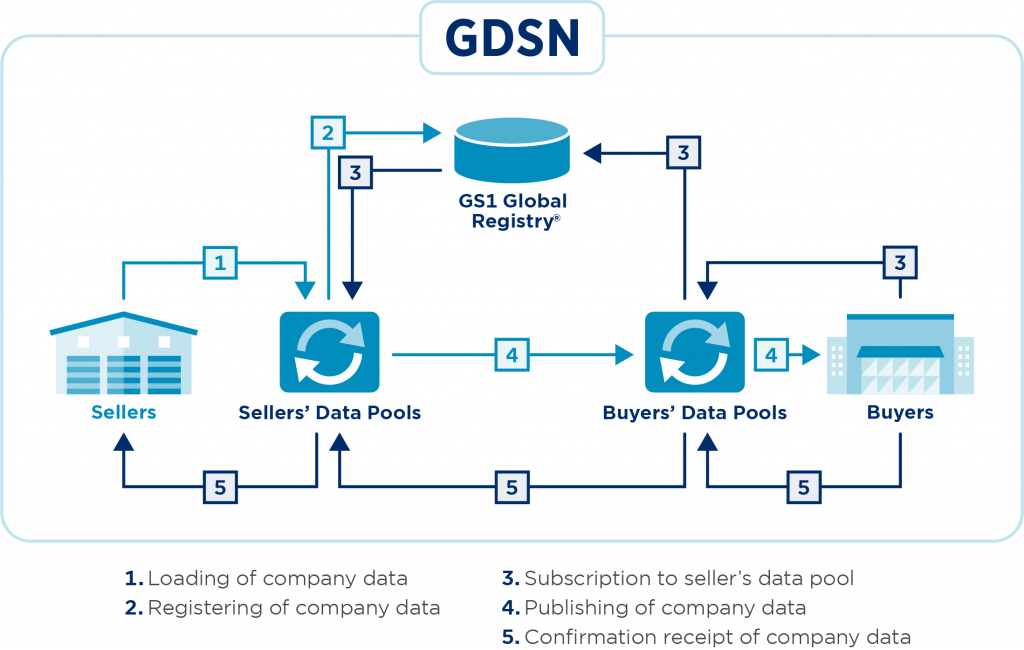
The Global Data Synchronization Network is an internet-based, interconnected system of interoperable data pools governed by GS1 standards. As the world’s largest product data network, GDSN enables businesses worldwide to exchange standardized product information seamlessly with trading partners.
GDSN operates through a structured publish-subscribe model:
- You load company data into a certified data pool
- Your data gets registered in the GS1 Global Registry
- Retailers subscribe to your data
- Your product information is published
- Trading partners receive confirmation of your data
This process ensures all stakeholders have access to identical, accurate information in real-time.
Connecting PIM with GDSN for Real-Time Updates
Integrating PIM with GDSN creates a powerful digital shelf management system. Initially, your PIM serves as the central repository for all product information before sending it to GDSN and other channels. This integration follows a systematic process:
- Data extraction and centralization in PIM
- Data cleansing and enrichment within PIM
- Registration and publication to GDSN data pools
- Subscription and synchronization with trading partners
Subsequently, whenever you update product information in your PIM system, these changes automatically propagate through GDSN to all subscribed partners, ensuring everyone works with current, complete information.
Ensuring Compliance with Retailer Data Requirements
GDSN adherence is not optional for serious digital shelf optimization. Currently, over 22 million Global Trade Item Numbers (GTINs) are registered in GDSN with more than 3000 different possible attributes.
First of all, GDSN validates all data against GS1 standards before distribution. This validation ensures your product information meets global standards and specific retailer requirements. Altogether, high-quality data is essential as it directly impacts:
- Supply chain efficiency
- Consumer trust
- Regulatory compliance
Non-compliance risks lost trading partners, incorrect orders, delayed shipments, and ultimately, lost sales.
Switch to Commport Datapool Solutions Today. Our GDSN and PIM Solutions Will Help You Centralize, Enrich, and Sync Your Product Data to Marketplaces in Real Time.
Optimizing Digital Shelf Performance with Analytics
Once your PIM and GDSN systems are in place, maximizing digital shelf performance requires ongoing monitoring and optimization. Digital shelf analytics (DSA) provides the insights needed to continuously improve your product visibility and sales conversion.
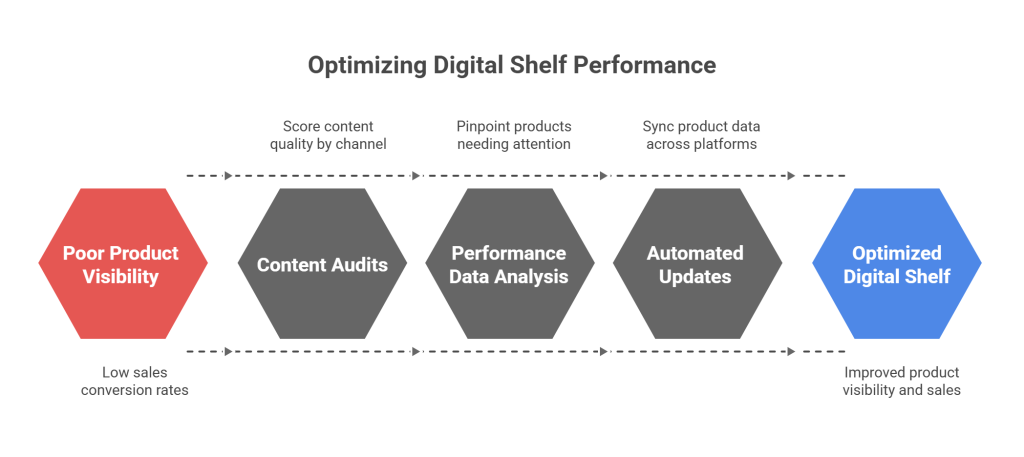
Using Digital Shelf Analytics to Track Content Quality
Digital shelf analytics acts as a guardian for your product listings, helping address critical issues such as poor product findability and incorrect information. Using intelligent automation, DSA continuously monitors your online product listings to generate real-time insights into content quality.
First of all, quality DSA tools perform regular content audits that provide specific content quality scores for each channel. Since each marketplace has unique content guidelines, these scores help ensure your product descriptions, images, and attributes align with platform-specific standards.
Through intuitive dashboards featuring trend charts, scorecards, and reports, I can clearly understand my digital shelf’s current state and identify actionable improvements.
Improving Product Content Based on Performance Data
Analytics reveals which product page elements work effectively and which require improvements. By examining performance data, I can pinpoint exactly which products are performing well and which need attention.
To enhance content performance:
- Prioritize changes based on their potential impact
- Implement changes systematically, one at a time, to identify individual impact
- Conduct additional keyword research for underperforming content
- Review content promotion strategies across relevant platforms
Now, when I identify issues like missing product information or blurry images, I can address them before they harm sales and brand reputation.
Automating Updates Across Channels
Manual updates often lead to errors like incorrect prices or stock levels. Automation solves this by syncing product data with platforms such as Google Shopping, Amazon, and Facebook.
Implementing automation tools saves significant time, yet requires clean, standardized data to be effective. Once established, automation handles product data for hundreds or thousands of listings without extra effort. Even better, these tools format listings to meet the rules of each platform, ensuring products look their best regardless of where they’re sold.
By creating this “closed loop” system between PIM, GDSN, and DSA, I maintain a constant, bidirectional flow of information that keeps my digital shelf optimized.
Conclusion
Digital shelf excellence stands as a critical competitive advantage in today’s expanding e-commerce landscape. Throughout this guide, we’ve examined how proper implementation of PIM and GDSN systems transforms scattered product information into a powerful asset that drives sales and customer satisfaction.
Most importantly, the centralization of product data eliminates silos between departments and creates a single source of truth for your entire organization. This centralized approach consequently reduces errors, speeds up product launches, and ensures consistency across all customer touchpoints.
The integration between your PIM system and GDSN further enhances this foundation by automating data syndication to retailers and marketplaces. Therefore, your product information remains accurate and up-to-date everywhere your customers shop, regardless of channel complexities.
Analytics completes this ecosystem by providing actionable insights into content performance. We can identify gaps, track improvements, and make data-driven decisions that continuously enhance our digital shelf presence. The combination of these three elements—centralization, syndication, and optimization—creates a robust framework for digital shelf excellence.
The path forward is clear. Companies that master their digital shelf strategy will capture a greater share of the growing e-commerce market. Those who fail to adapt will continue struggling with inconsistent product information, missed sales opportunities, and diminishing customer trust.
Your digital shelf represents every opportunity to connect with customers online. The steps outlined in this guide provide a practical roadmap to transform this critical asset from a pain point to a primary driver of business growth. The question isn’t whether you should invest in digital shelf excellence, but rather how quickly you can implement these changes to stay ahead of competitors who are undoubtedly pursuing similar strategies.
Commport Datapool Solutions
Download: GDSN Buyers Guide
Empower your business with global data synchronization; download our GDSN Buyer's Guide today and take the first step towards streamlined, accurate, and compliant product data management.
Frequently Asked Questions
A digital shelf refers to all online touchpoints where customers can interact with your products, including retailer websites, marketplaces, and mobile apps. It’s crucial because it impacts how consumers discover, research, and purchase products in the e-commerce landscape.
A PIM system centralizes and standardizes product information, eliminating data silos and ensuring consistency across all channels. This improves operational efficiency, reduces errors, and enables faster product launches, ultimately enhancing the overall digital shelf performance.
GDSN (Global Data Synchronization Network) is a system that enables businesses to exchange standardized product information with trading partners worldwide. It ensures real-time updates and compliance with retailer data requirements, improving supply chain efficiency and consumer trust.
Digital shelf analytics provides insights into content quality and performance across different channels. It helps identify areas for improvement, tracks the impact of changes, and enables data-driven decisions to enhance product visibility and sales conversion.
Automating updates across channels saves time, reduces errors, and ensures consistency in product information. It allows businesses to efficiently manage large numbers of product listings while adhering to platform-specific requirements, ultimately improving the overall digital shelf presence.


